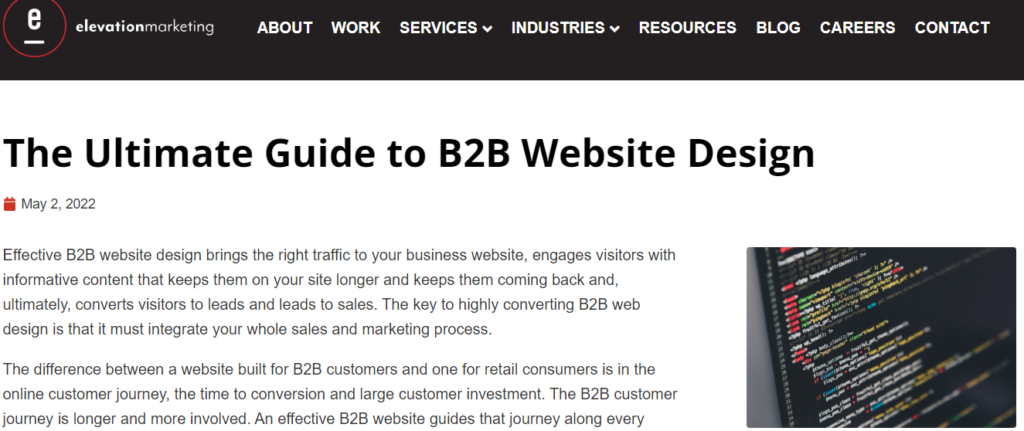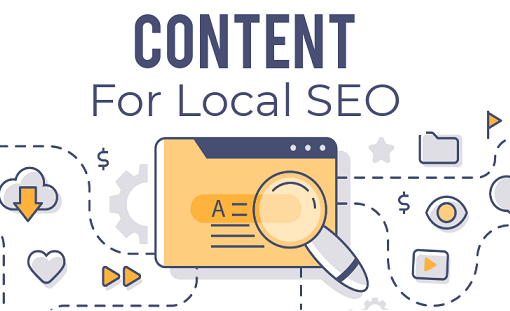To rank well in search engines, your website content must be both SEO-friendly and reader-friendly. This can be a difficult balance to achieve, but it is not impossible.
It may seem like these two goals are at odds with one another. But in truth, writing content that is reader-friendly is one of the best ways to ensure your content is also SEO-friendly.
In today’s post, we’re taking a look at the benefits of writing with actual humans in mind, the importance of readability in SEO content, and we’ll give you three key tips to help you leverage one of the most important search engine ranking factors in 2022: user engagement.
Let’s dive in!
CONTENTS
- Writing Copy for Humans vs. The Algorithm
- Readability Is a Ranking Factor
- Tip 1. Write for Your Target Audience First (and Always Consider Intent)
- Tip 2. Keep Your Keywords In Mind
- Tip 3. Let Your Headings and Subheadings Tell a Story
Writing Copy for Humans vs. The Algorithm
To make sure your content ranks well on search engine results pages (SERPS), you need to ensure your content meets all the requirements and best practices for proper SEO. That means keeping in mind what the search algorithms are looking for as you’re planning, writing, and formatting.
While it’s true that figuring out what, precisely, the algorithms are looking for can be something of a mystery, Google has given us a few hints (and some direct requests as well).
We know, for example, that links – both internal links and backlinks – play a big role in how Google views and ranks a piece of content. Mobile-first design is also critical, as is the consistent publication of engaging content.
One key ranking factor whose importance is on the rise is user engagement, and that correlates directly to how reader-friendly your content is.
To create reader-friendly content your posts should be:
- Engaging and interesting
- Easy to read and understand
- Relevant to your target audience
If you can keep the dual goals of creating both algorithm-friendly and reader-friendly content in mind while you’re writing, you’ll be well on your way to creating compelling content that ranks well in search engines.
Sounds simple, right? Well, that’s not always the case.
Readability Is a Ranking Factor
It can be difficult to find the right balance between writing for both search engines and humans. Many publishers continue to sacrifice readability for a better SERP rank by turning to old-school SEO tactics, and it shows. There are a few key problem areas that tend to make content not so fun to read – for humans at least.
These readability-killing errors include:
- A high keyword density: Repeating keywords and key phrases over and over again – also called keyword stuffing – can be distracting for readers.
- Unnatural keyword usage: Sticking too rigidly to exact-match keywords and phrases (for example, best plumber in Anytown, USA) drastically decreases the readability of a piece of content.
- Too much focus on a geographic area: Local SEO is important for local businesses, of course, but constantly repeating Anytown, USA at the end of each keyword is a dead giveaway that the content was written for an algorithm and not a human being.
- Titles and headings that don’t tell a story: If you’re using your titles and headings as just another vehicle for a keyword, you’re missing a critical opportunity to make your content more readable for actual humans.
It’s important to remember that readability is, in a way, its own ranking factor.
Remember user engagement? That ranking factor on the rise that we mentioned before? User engagement is directly impacted by how readable a piece of content is, and its importance has surged in 2022 to become one of the top five ranking factors.
That’s right. User engagement can now be considered one of the most important ranking factors alongside the ones we’re all familiar with like quality backlinks. How long a user stays on your landing page after a keyword search signals to Google that your content is readable and likely matches the searcher’s intent.
Head on over to Google Analytics and spend some time diving into the metrics to determine how engaging your content really is.
These Google Analytics metrics can tell you how reader-friendly your content is:
- Average time on page: A longer time on the page means that readers are sticking around to read your content, and that’s a good indication that your content gives them a comprehensive answer to their search.
- Bounce rate: A bounce is a single-page session on your site. While higher bounce rates are to be expected for blogs (after all, the user got the answer they were looking for, without the need to dig deeper and visit other pages) it should still be your goal to create content that encourages a lower bounce rate…
- Pages per session: Have you ever read a blog post so engaging that an hour later you realize you’ve gone down the rabbit hole by clicking all the links presented in the original article to learn more? This is measured by average pages per session. A higher number of pages per session means that your users are visiting more than one page on your website after reading the content on the page they originally landed on – a clear sign of an engaging piece of content!
Below we’ll dive into a few ways you can write search algorithm-friendly content while emphasizing readability and engagement.
Tip 1. Write for Your Target Audience First (and Always Consider Intent)
Before you even start thinking about keywords or search engine optimization, you need to know who your target audience is. Who are you writing for? What kind of information do they need from you? Once you have a good understanding of your target audience, only then can you start creating content that appeals to them.
The ability to understand what a searcher is hoping to find and then matching your answer to their search query is critical when it comes to writing compelling content.
Do these two things to ensure your content aligns with the reader’s intent:
Have a Deep Understanding of Your Target Keywords and Adjust Accordingly
What do you think a searcher who types in “Content Marketing” is trying to find? That’s a hard question to answer without digging a little deeper. Perhaps they’re trying to understand what content marketing is. Maybe they want to know how to do content marketing themselves. That keyword alone doesn’t give us content creators much to go on.
To get a better understanding of the intent behind your chosen keywords, try entering them into a Google search and taking a look at the “People Also Ask” (PAA) box. In our example above, it becomes clear that the typical intent behind a search for “Content Marketing” is likely not an intent to purchase, but rather an intent to learn about the trade.

However, bear in mind that you may be better off focusing on keywords with a narrower intent. Broader keywords like “Content Marketing” will naturally find their way into your content as you write.
Consider Where Your Reader Is In Their Journey
A searcher who types in “how to grow a B2B business” is in a very different stage of the buyer’s journey than one who types in “top B2B content agencies in the U.S.” The former indicates someone who is in the awareness stage of their journey while the latter points to someone who is evaluating potential partners. Being overly salesy in top-of-the-funnel content, for example, does not take the reader’s intent into consideration. You can expect your user engagement metrics to take a turn for the worse.
Tip 2. Keep Your Keywords In Mind
Once you know who your target audience is and what they want to read, it’s time to start thinking about how to use your keywords.
But beware: it’s not as simple as adding in your exact keyword over and over. We all know by now that when you stuff your content full of too many keywords, you’ll turn off both your readers and the search engines.
Instead, use exact-match keywords thoughtfully and sparingly, putting them mostly in subheadings, and the first few sentences of your blog post or article. After that, if you’re following tip one and writing with search intent in mind, your copy will naturally support your target keywords.
Much of this support is accomplished through the use of semantic keywords. Semantic keywords are words and phrases that are conceptually related to the original keyword.
To give you an example, we created this blog post on B2B website design:

Throughout, we included terms like “website development”, “integrated B2B website”, and others that searchers may use when searching for similar concepts. All of those words can be considered semantically-related to the primary keyword “B2B Website Design”.
The image below from ahrefs demonstrates how Google might evaluate semantically-related keywords to determine which result to return first for a search for “dogs.” Even though both pages used the keyword “dogs” the same number of times, Google chose the option that contained words clearly related to “dogs” as the use of semantic keywords made it clear that it was more likely to match the searcher’s intent.
By focusing on writing an informative, helpful piece of content that is on-topic and takes search intent into consideration, you really don’t have to think about keyword usage all that much.
Tip 3. Let Your Headings and Subheadings Tell a Story
Not only do headings and subheadings help to break up your content and make it more readable, but they also give you another opportunity to boost your readers’ engagement and positively impact your SEO.
About 80% of readers merely skim content instead of reading the whole thing. So what does that mean for that deep-dive masterpiece you wrote?
If you can understand the key points of your article just by reading the headers and subheaders, then you’re well on your way to encouraging skimmers to scroll all the way down – an engagement metric considered by search algorithms – and maybe even dig a little deeper.
Try these tricks to make your content skimmable:
- Always outline your content: Your outline is the perfect place to plan the different sections of your post. Do the titles and subtitles in your outline tell a complete story? If not, adjust accordingly. Sure, you can’t give a reader all the juicy details in the headlines, but you can at least give them an idea of what your key points are.
- Consider bolding key concepts: As readers skim a piece of content, their eye is naturally drawn to whatever stands out. Making the key points in a section bold is a great way to make sure they walk away with the most useful, important information, even if they’re just scanning.
- Avoid walls of text: There’s nothing less fun than being confronted with a solid wall of text when you’re looking for the answer to a question. You just know you’ll be forced to read and read without any guarantee that the answer you’re looking for is even contained in the text. To help engage your readers, break up walls of text with things like bulleted lists, images that provide extra value like infographics, key quotes, or even just a few blank lines here and there.
Final Thoughts
It’s time to say goodbye to the notion that writing SEO-friendly content means sacrificing readability and writing for the bots. With user engagement metrics playing a critical role in search rankings in 2022, you can rest easy knowing that by writing for your readers and providing them with real value, you’re also furthering your search ranking goals.




